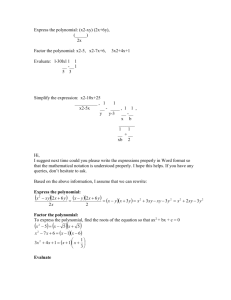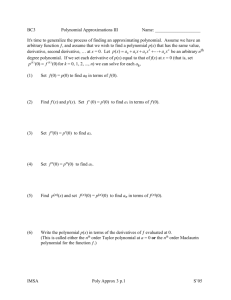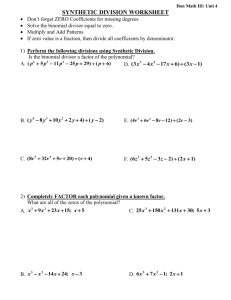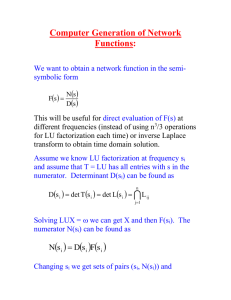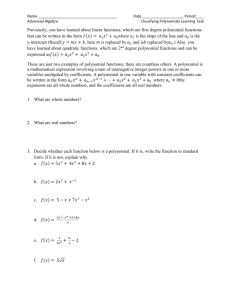aero flying squirrel Supplementary material Sources of error
advertisement
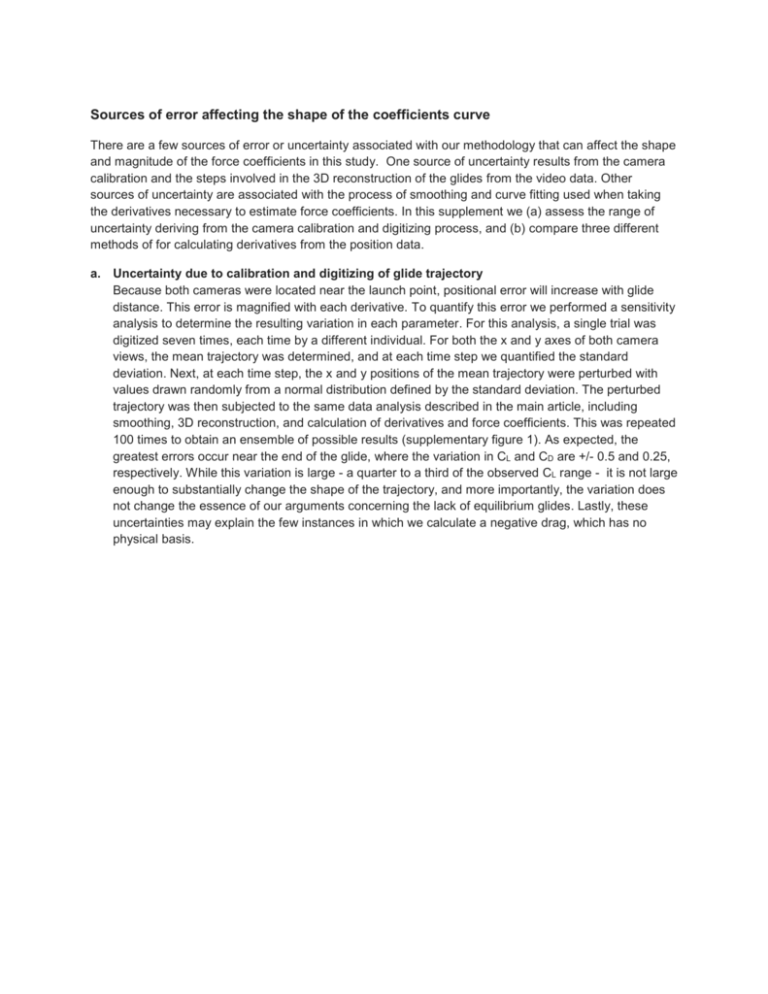
Sources of error affecting the shape of the coefficients curve There are a few sources of error or uncertainty associated with our methodology that can affect the shape and magnitude of the force coefficients in this study. One source of uncertainty results from the camera calibration and the steps involved in the 3D reconstruction of the glides from the video data. Other sources of uncertainty are associated with the process of smoothing and curve fitting used when taking the derivatives necessary to estimate force coefficients. In this supplement we (a) assess the range of uncertainty deriving from the camera calibration and digitizing process, and (b) compare three different methods of for calculating derivatives from the position data. a. Uncertainty due to calibration and digitizing of glide trajectory Because both cameras were located near the launch point, positional error will increase with glide distance. This error is magnified with each derivative. To quantify this error we performed a sensitivity analysis to determine the resulting variation in each parameter. For this analysis, a single trial was digitized seven times, each time by a different individual. For both the x and y axes of both camera views, the mean trajectory was determined, and at each time step we quantified the standard deviation. Next, at each time step, the x and y positions of the mean trajectory were perturbed with values drawn randomly from a normal distribution defined by the standard deviation. The perturbed trajectory was then subjected to the same data analysis described in the main article, including smoothing, 3D reconstruction, and calculation of derivatives and force coefficients. This was repeated 100 times to obtain an ensemble of possible results (supplementary figure 1). As expected, the greatest errors occur near the end of the glide, where the variation in CL and CD are +/- 0.5 and 0.25, respectively. While this variation is large - a quarter to a third of the observed CL range - it is not large enough to substantially change the shape of the trajectory, and more importantly, the variation does not change the essence of our arguments concerning the lack of equilibrium glides. Lastly, these uncertainties may explain the few instances in which we calculate a negative drag, which has no physical basis. aero flying squirrel Supplementary material Supplementary figure 1. Variation in parameters due to random digitizing perturbations. Red represents vertical and blue represents horizonta. A) position. B) velocity. C) acceleration. D) force. Red represents lift, and blue represents drag. E) force coefficients. Red represents CL and blue represents CD. F) Lift-todrag ratio. b. Uncertainty due to smoothing and calculations of derivatives. There are many possible ways to smooth and differentiate the trajectory data, and the results can vary considerably based on the method chosen. We explored this quite extensively, comparing different methods and using a range of smoothing parameters, before selecting a method that offered the best balance of accuracy, robustness, and smoothness. Here we describe and compare several methods. Fitting a single polynomial to the entire trajectory: The challenge with this method is that the second derivatives (accelerations, which are proportional to the force coefficients) at the beginning and end of the trajectory often behave wildly and this inaccuracy increases with higher order polynomial fits. Examples are shown for 2nd, 4th, and 6th order polynomials fit to the raw trajectories (supplementary Fig 2). 2 aero flying squirrel Supplementary material Supplementary figure 2: Examples of fitting a single polynomial to entire trial. Curves represent fitting 2nd, 4th, and 6th order polynomials to the three global axes. In column 1 (position), red circles represent raw data, and blue lines represent the fitted curves. In column 2 (velocity) and 3 (acceleration), blue lines represent the derivatives for the three polynomial fits. Moving window polynomials: A common method used to reduce the influence of the middle of the glide on the ends is to fit a polynomial to smaller “windows” of data and then to evaluate derivatives from the local polynomial. A very small window amplifies small fluctuations in the raw data, resulting in a very noisy estimate for acceleration. As the window grows, the acceleration estimate becomes smoother, but at beginning and end of the trajectory the estimate becomes more extreme, as when fitting a single polynomial to the entire trajectory. We adopted this moving window method, choosing a window of 25% the total glide length because this value produced the best balance between the accuracy of a local fit, especially at the ends, and the smooth accelerations capabilities of a larger window. Smoothing Spline: This method (“spaps”, in MATLAB) fits a quantic spline to the entire data set, and smooths it according to a desired balance between a least-squares regression of the raw data and a measure of roughness of the second derivative. This method was found to give comparable results to the moving window method, with a window of 25% (Supplementary figure 3). However, we did not adopt this method because the results were very sensitive to the smoothing parameter of the spline algorithm and the predicted force coefficients at the end of the glide were more extreme than the estimates found using the moving window polynomial method. 3 aero flying squirrel Supplementary material Supplementary figure 3: Comparison between the original moving window polynomial fitting (solid lines) and smoothing spline (dashed line) methods for smoothing and estimation of derivatives for a sample flight trajectory. 4
